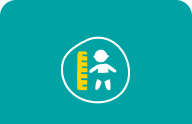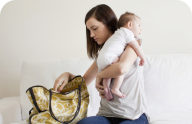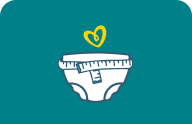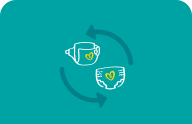When to Start Potty Training: 7 Signs Your Child Is Ready
When it comes to potty training, and when to start potty training, patience is usually rewarded. Many parents find that the best plan is to wait until their child shows signs of readiness, rather than bowing to pressure from friends or family to jump-start the process too early, or to have their child potty trained by a certain age or deadline.
Read on to discover some of the signs that your little one is getting ready to start potty training, how to prepare your child for potty training, and how to start potty training.
<H2>Signs of Readiness for Potty Training</H2>
A key point to remember is that there’s no single “right age” for when to potty train — a process that requires your little one to develop a complex set of skills. You know your child best, and you might sense when the time is right. Learning how to use the potty might be easier and go more quickly when your child is at least 2, or even a little older.
In fact, instead of focusing on age, you might find it’s better to look out for the signs that your little one is getting ready to start potty training.
<H3>What Are Some Potty Training Readiness Signs?</H3>
Here are some signs that your child may be ready to start potty training:
Your child shows an interest in learning to use the potty and wants to be more independent. For example, your little one might show interest by asking questions if they see a family member going to the bathroom.
Your child can understand and verbalize words about using the potty. For example, they might say “my diaper is dirty” or “I need to go pee pee. ” They might even tell you they need to go potty even if their diaper is already dirty or wet.
Your child can make the connection between having the urge to pee or poop and going to use the potty.
Your child can follow simple instructions and likes to copy your behavior, including bathroom habits.
Your child can keep his diaper dry for at least two hours.
Your child can get on the potty, stay on the potty long enough to pee or poop, and get off the potty.
Your child can pull down his own diapers, training pants, or underwear.
<H2>When Will Your Child Be Ready for Potty Training?</H2>
Although early training is possible, studies show that many children who begin potty training before 18 months aren’t completely trained until after the age of 4. In contrast, children who don’t start training until around the age of 2 are likely to be fully potty trained before they turn 3.
Girls tend to be ready to potty train a little earlier than boys, but the readiness signs for both boys and girls are the same.
As you go through all those diapers or disposable training pants before your child is fully potty trained, why not get some great rewards and coupons for your Pampers products? Download the Pampers Rewards app to get started.
<H2>Things You Can Do to Prepare Your Toddler for Potty Training</H2>
Before you even notice the signs that your child is ready, there are things you can do to get them set for potty training and make it a smooth experience.
Tackling some of these pre-potty training steps will help familiarize your child with the concept of the potty before training begins. It may also make the process less scary and confusing for your child, which in turn may make potty training your little one easier for you.
Here's what you can do to prepare your child for potty training:
Get a potty chair to keep around the house, explaining in simple terms what it’s for and how it works. When you’re choosing your child’s potty seat, perhaps you can let your child pick one they like to help them get more excited about the potty.
Use words like “pee pee” and “poop” to familiarize your child with what’s happening when you’re using the toilet or when you’re changing a dirty diaper.
As your child gets a bit older and closer to actual potty training (and you’ve spotted some of readiness signs mentioned above), show him where the poop from his diaper goes, and let him put it in his potty or flush it down the toilet.
If possible, let your child watch when other family members of the same sex use the toilet.
<H2>How to Start Potty Training</H2>
Once you notice most of the readiness signs discussed earlier, it's a good time to kick off potty training.
Starting with bowel training is a smart move, focusing on when your child is about to do number two. Kids often can't tell peeing apart from pooping since it usually happens together. Once bowel training is established and your child is typically successfully pooping in their potty chair, most children — especially girls — will begin to relate the pooping with peeing and then can start to understand the difference between them.
Because you’ll start potty training with a focus on bowel training, boys usually learn to pee sitting down. However, they can gradually learn to do it standing up. Imitating an older sibling of the same gender or maybe Dad can help him learn. There are also books you could refer to that show how boys can pee standing up.
If you started preparing your child for potty training in advance, you probably already have a potty chair at home.
<H3>The First Steps of Potty Training</H3>
Once your child is familiar with their potty chair, these are some steps you can take to start potty training:
Let your child sit on their potty fully clothed while you talk to them about the potty and what it’s for.
Once your child is sitting on the potty by themselves without being prompted, you can try getting them to sit there with their diaper off. Don’t make your child sit on the potty if they don't want to.
When they're comfortable with that routine, try changing their diaper while they're on the potty. If they pooped, show them how you drop the poop into the potty chair or the toilet.
Introduce the habit of handwashing every time your child gets off the potty, even if they didn’t pee or poop.
An important thing to remember is to keep the experience positive and praise your child for all their potty successes. If you can make potty training fun, your little one will have an easier time making this transition.
<H2>When to Delay Potty Training</H2>
Trust your instincts on whether or not the time is right to launch into potty training. Even if your toddler is showing signs of being ready for potty training, you might want to put off introducing this new skill in the following situations:
If your child is sick
If you’re in the middle of traveling
Around the birth of a sibling
If your child is transitioning from the crib to a bed
If you’re moving to a new home.
Starting potty training can be a great learning experience for your little one if they're ready for this next step towards more independence. Although accidents will happen along the way, staying patient and positive will help your little one learn more quickly and have fewer problems with it. Have fun and good luck!
And don’t forget to download the Pampers Rewards App, which helps you along the way with expert tips, helpful tools, and rewards for the Pampers products you already use.
Read more about Toddler
Join a World of Support
through Pregnancy and Parenthood.
TRACK WITH TOOLS
LEARN WITH EXPERTS
GET REWARDED












